Ballnine Spitballin’ Fred Lynn By Rocco Constantino May 25, 2023
This article was originally featured at Ballnine.com By Rocco Constantino May 25, 2023
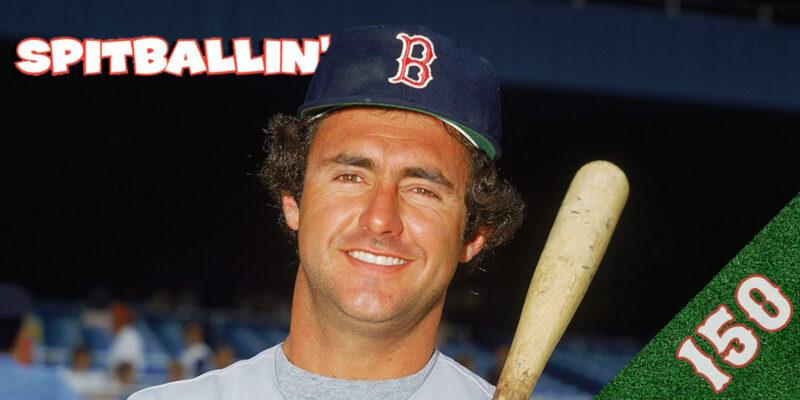
In the summer of 2020, I had an idea for BallNine, which at the time had just launched as the brainchild of EIC Chris Vitali. I thought it would be a great idea to catch up with players from previous generations and let them tell fun stories about their baseball lives.
Like most of my ideas, I didn’t know what I was getting myself into. Chris agreed because he is always up for hare-brained schemes that aren’t too well-thought out. I reached out to Al Ferrara because I wanted to hear his stories about playing for the Dodgers while also working as an actor on Gilligan’s Island and Batman. It went great, but I didn’t know how many more of these I’d be able to do.
Well, three years later we haven’t missed a single Friday and we have come to the 150th installment of Spitballin’.
With some early guidance from AMBS himself, Kevin Kernan, we’ve been able to refine these and have talked with players who have played in nine different decades. We have also spoken with scouts, managers, coaches and even relatives of some of the game’s greats.
For the 100th edition of Spitballin’, my guest was Luis Tiant. For the 150th milestone, we wanted to find another worthy headliner – and turned to a teammate of El Tiante’s with the Red Sox.
Thank you to everyone who has generously shared their stories with fans and to those readers who have been so kind to support Spitballin’.
I’m looking forward to working towards the next milestone but first, please join us for a special 150th Spitballin’ with the great Fred Lynn!
Thank you for joining us, Mr. Lynn. Really honored to have the chance to speak with you. Can you tell us what baseball was like for you as a kid?
I grew up in El Monte, which is a suburb of Los Angeles. It was a blue collar town and every kid played every sport. We would play anything out there in the street. Games like over the line or pickle and we’d try not to hit any cars or windows. Back then, if we weren’t playing organized sports, we were at the school playing something. Depending on the number of guys we had, we could make up any game. Everyone knew everyone and you could always find a game. I didn’t start playing Little League until I was 10 and I played with 11 and 12 year olds. The first couple of weeks, I had problems hitting the ball. One of my coaches would call me “K-O,” because I always struck out. But I got the hang of it and made the All-Star team.

1975: Fred Lynn of the Boston Red Sox was named as an All-Star, Rookie of the Year, MVP and topped it off by winning a Gold Glove.
And from what I can tell, once you found it, you were a great athlete the rest of your life. Can you take us through the next steps that eventually landed you at USC to play baseball and football?
I played football, basketball and baseball in high school and was being recruited by colleges in all three sports. Football was going to get me to the major universities. Nobody was paying full freight to play baseball back then. I was being talked about as a first round pick out of high school but we told them all I was going to USC to play football and baseball. It was going to take a phenomenal amount of money to pass that up; like six figures which was unheard of. When the draft came, I wasn’t paying attention because we told everyone I was going to school. The Yankees drafted me in the third round anyway, which was a total surprise. The scout came to our house and we were sitting in the living room. My dad said, “We told you guys that my son was going to USC, you just wasted a pick. Why did you draft him?” The scout said, “Well, we’re the New York Yankees!” My dad said, “Well, there’s the door!”
You guys were telling the truth. When you were at USC, what ultimately led you to choose baseball over football?
Back then, I was the second class where freshman could play varsity baseball. In football, we had our own team; freshmen weren’t allowed on varsity football. I made the baseball team as a freshman and we won the College World Series. I was on the All-Tournament team too. After that tournament, the Pan Am Games were going on. I went to Miami to try out for Team USA and made that team. We went down to Cali, Colombia to represent the United States and we lost to Cuba in the championship game. I won a Silver Medal though and led the tournament in home runs as a freshman. I could see the handwriting on the wall that baseball was going to be where I ended up, so when I got back to USC, I quit football to concentrate on baseball.
I’M NOT A BIG GUY, BUT I PLAYED WITH A FOOTBALL MENTALITY. I WASN’T AFRAID TO DO THINGS ON THE FIELD AND IT COST ME. I WOULDN’T TRADE MY STYLE OF PLAY TO MAKE THE HALL OF FAME.
That is a pretty incredible freshman year and things only went up from there. What do you remember about your last two years at USC?
As a sophomore, we won the College World Series again and after the season, we went to Japan to play the Japanese All-Stars. We played where there Major League teams played in Tokyo and Yokohama. We were there for two weeks and I won the tournament MVP. Then the next year, we won the College World Series again and this time the Japanese All-Stars came to us – and we played at Dodger Stadium and Angels Stadium – so I got to represent the USA three different times. I had a pretty big resume coming out of amateur baseball. I was doing things nobody had ever done because freshmen weren’t allowed to compete at this level before me. When I signed professionally, I had a huge advantage because of all those experiences.
Of those three College World Series you won at USC, do any of them stand out to you above the others?
I don’t know that we were ever ranked number one coming into any of them. One year, Arizona State was like 60-4. They had some kind of crazy record. How can you win that many games? We ended up beating them. Probably the most memorable game was when we played the University of Minnesota and Dave Winfield was pitching for them. He had struck out 15 and I think we had one hit going to the ninth inning and we were down 7-0. We scored eight in the bottom of the ninth to beat them and then we won the title the next day.
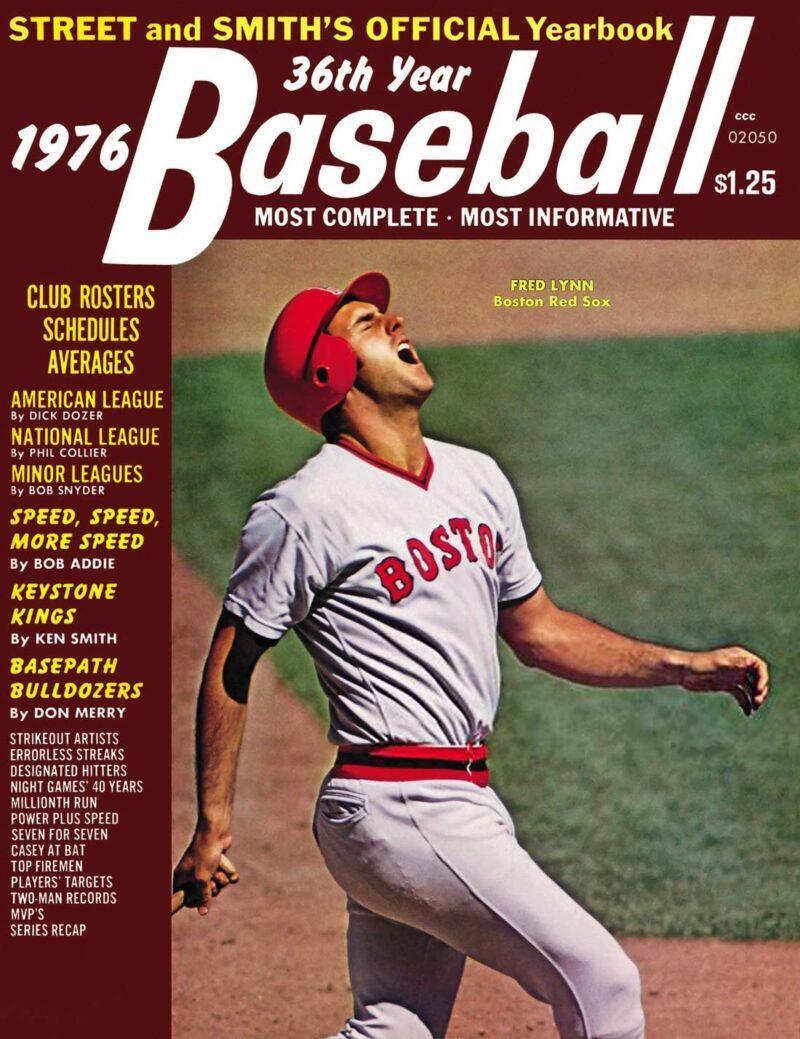
1976 Street and Smith’s Cover. (Photo by Sporting News via Getty Images Archive)
You jumped up to the Major Leagues after just a season and a half in the minors and got off to a fast start – hitting a home run in your first Big League at bat. Can you talk about that first experience in the Majors?
Darrell Johnson had pinch hit me three times when I first got called up and I had never pinch hit in my life; I was always in the starting lineup. I made outs each time then got a start against the Brewers and Jim Slaton. I knew he was a fastball-curve ball guy and he started me with a fastball and I hit it right on the button. It had home run distance but went foul. The next pitch he threw me a curve and I hit it out to right. My second at bat I hit a double off him, so I was 2-2 with a double and homer in my first Big League start. Then they brought in a lefty and they took me out! Tim McCarver said to me, “Nice game, kid. Now go take a shower.” I was like, “Holy crap. The team isn’t hitting and I go 2-2 and he takes me out?” I hit really well that first September callup. It was a great experience leading into the 1975 season.
That 1975 season was historic and I have a few questions about that. First, what plan did the Red Sox have for you going into Spring Training?
Rick Miller, Juan Beniquez and I all played centerfield. Jim Rice was coming up and he was a left fielder, but Carl Yastrzemski was already there. We had Cecil Cooper and Dwight Evans as young players too. We had Bernie Carbo too. It was crowded in the outfield. Eventually they traded Cooper so they could move Yaz to first which opened left for Jimmy. My line to the press was, “I’m here just trying to make the club,” but in the back of my mind I was always thinking, “There’s no way I’m not making this club.” I just crushed it that Spring and when we went north, we took all those outfielders. It took a while to get the lineup set. Yaz and Jimmy would spend time at DH and Cooper would play a little first to give Yaz a day off.
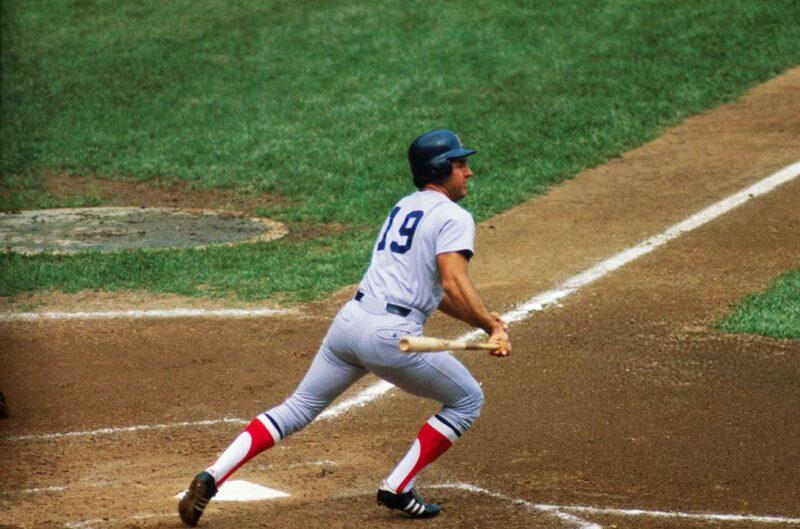
Fred Lynn of the Boston Red Sox batting against the New York Yankees at Yankee Stadium, Bronx, NY.
You were batting .342 with 16 homers at the All-Star break as a rookie in 1975, so needless to say, you made the All-Star team. Looking back, 18 Hall of Famers played in that All-Star Game. What was that experience like as a rookie?
That was pretty special. I wasn’t even on the ballot. I was a write-in candidate. When I got there, the first thing I was thinking was, “Holy crap, Henry Aaron is on my team!” He was at the end of his career, but he was still there. I ended up facing Tom Seaver and he was a USC Trojan too. I just missed one on him and flew out to deep center. The next year, the All-Star Game was in Philadelphia and I was starting. Tom Seaver started for the NL and I was hitting fifth. He threw that same fastball I saw the year before and I hit it out. So, my first hit in the Majors was a home run and my first hit in the All-Star Game was a home run.
That 1975 season ended up with you winning the MVP, Rookie of the Year and Gold Glove. You get a lot of attention for the incredible offensive season you put up, but I think it overshadows how great you were on defense too. Not many rookies come into the league and win a Gold Glove right away. Could you talk about that?
I always considered myself a defender before I was a hitter. I felt like playing center in the Majors, I got to use a lot of the athletic ability I developed in basketball and football. Once the ball was hit, I knew where I was gonna go and the footwork was instinctive; I didn’t even have to think about it. I loved playing at Fenway because of the nuances in the outfield. The angles, the ladder, the speakers, doorways, wrought-iron fences. It made things interesting. I didn’t like cookie-cutter ballparks; they were boring. I loved playing defense in Fenway and the fans always appreciated it.
Offensively, I don’t even know where to start. You batted .331 with 21 homers and 105 RBIs and led the league in doubles (47), OPS (.967) and slugging (.566). At any point in the season were you able to take a step back and realize the type of season you were putting up?
Not really, I was too in the moment. The Sox hadn’t won much during that era so my focus was always on winning the game. As a rookie, I was seeing ballparks and pitchers for the first time. If I was preparing to hit against Jim Palmer for the first time, I had to really focus on that. Fortunately for me, I wasn’t the only rookie. Jimmy Rice and Rick Burleson were rookies too. So that’s three of the starting nine as rookies. Plus Coop and Evans were very young. I tell people all the time I think that’s why we were so identifiable. Boston is a young town with all the colleges there. Most of the people in the bleachers were college and high school kids and they identified with us because we were the same age.
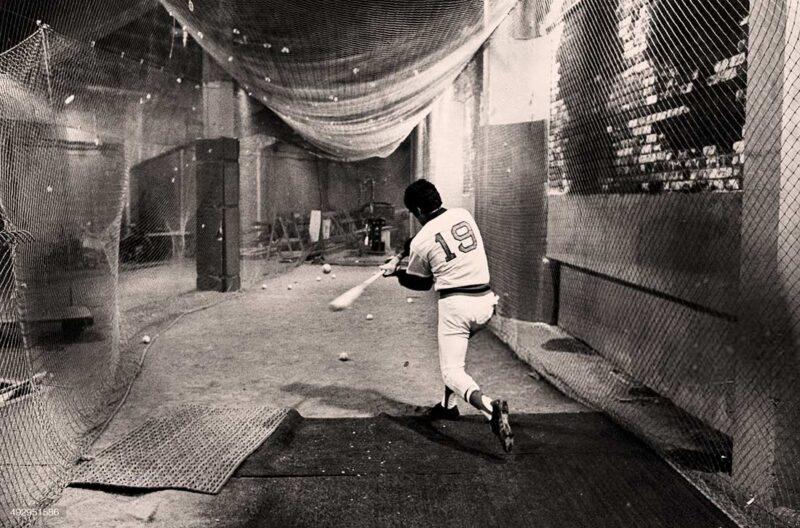
World Series 1975: Boston Red Sox Fred Lynn practices batting beneath the bleachers during a rain delay at Fenway Park in Boston on Oct. 20, 1975. (Photo by George Rizer/The Boston Globe via Getty Images)
We’ve talked so much about the ’75 regular season and of course that led to the 1975 World Series, which many consider the best ever played. You guys split the first two at Fenway and then moved to Riverfront Stadium for three games. Can you talk about going to Cincy and having to at least win one game there?
Tony Perez had a two-homer game [in Game 3] and I remember Evans having a big homer there too. What sticks out to me was making some good defensive plays to help us win. One thing that still bothers me is the Ed Armbrister bunt play with Carlton Fisk in Game 3. He bunted the ball right in front of the plate and Fisk ran into Armbrister as he was trying to field it. I was backing up second, so I saw the whole thing. Armbrister stopped and was in the way. Pudge pushed him and threw high to second. That runner went to third and scored and we lost by one run. That’s a huge play in the series. If he’s called out like he should have been, the runner goes back to first and doesn’t score. We lost that game by one run. We win there, and there might not even be a Game 7. Larry Barnett was the umpire and boy did he catch heck every time he came to Fenway. All those games could have gone either way. It’s funny, my rookie card for Topps in 1975 was one of those cards where there’s four guys on the card. Who do you think is next to me on my card? Ed Armbrister! Every time I see that card I want to cut him out!
Jumping to Game 6, arguably the greatest World Series game ever played. There were three home runs hit by the Sox that game and you were involved in each one. The first one was a three-run homer you hit in the first, you were on base for the Bernie Carbo one and on deck for Fisk’s home run. Why don’t you take us through each of those?
I was the centerpiece of the action all game! We went down three games to two, then there were three straight days of rainouts. The weather was brutal. The games went from weekend games to midweek, which changed things. We barely even took batting practice those days because there was no place to hit. The first inning we got a couple of guys on and I hit one about 20 rows over the bullpen. I hadn’t hit a ball that far since May and that really got the crowd into it, which was important. The Reds could hit too, though, and they caught us and passed us and were up 6-3 in the eighth. I started the inning with a single then Rico Petrocelli walked. Carbo pinch hit against Rawley Eastwick with two outs. He had two strikes on him and Eastwick threw a pitch that was literally just about in Bench’s glove. Bernie just flicked his bat late and fouled it off. I thought, “Oh man that was just about the worst swing ever.” But the next pitch was out over the plate where Bernie liked it. As soon as he hit it, I spun around and knew it was gone. Fenway went absolutely crazy. The game was now tied 6-6. That might have been the loudest roar I ever heard, even louder than Fisk’s homer. We were down and now we were back in it!

Boston Red Sox OF Fred Lynn slides home during Game One of the 1975 World Series against the Cincinnati Reds at Fenway Park in Boston on Oct. 11, 1975. (Photo by George Rizer/The Boston Globe via Getty Images)
It’s just so incredible to watch any of the documentaries about that game. I can never get enough. What was it like being on deck for the Fisk homer?
Pat Darcy had gotten six straight outs and he was a groundball pitcher. The thing about it though was that Fisk was a low ball hitter. Pudge said to me, “Freddie, I’m gonna hit one off the wall, you drive me in.” I said, “OK, that sounds like a good plan.” Darcy threw one down and in and Pudge just crushed it. I had a perfect view of it and knew it was out as long as it stayed fair. He actually hit the ball so hard that it didn’t have a chance to hook foul. If it was in a bigger ballpark, it may have hooked foul. That was after midnight and we played Game 7 the next day, so we actually ended up playing Game 6 and 7 in the same day!
That’s crazy to think about it that way! What an incredible moment. Now you had all those great memories in Boston, but were traded to the Angels in January of 1981. Did that trade come as a surprise?
Not really. They were trying to figure out how to deal with me, Burleson and Fisk. We had five-year contracts we signed in 1976 and ownership didn’t like that too much. They traded Rooster first and then sent contracts to me and Fisk late. We were gonna be declared free agents. I agreed to a trade and they sent me to the Angels, so at least they got some bodies for me. Fisk left as a free agent. I wasn’t surprised though because they were beating the drum all season about it. They were saying I wanted to leave, I wanted to play out West and that I wanted too much money and none of that was true. I wanted to stay. Those guys were my friends there and I knew we could win. I wasn’t surprised, but I was disappointed. I loved playing there and always wanted to be a Red Sock.
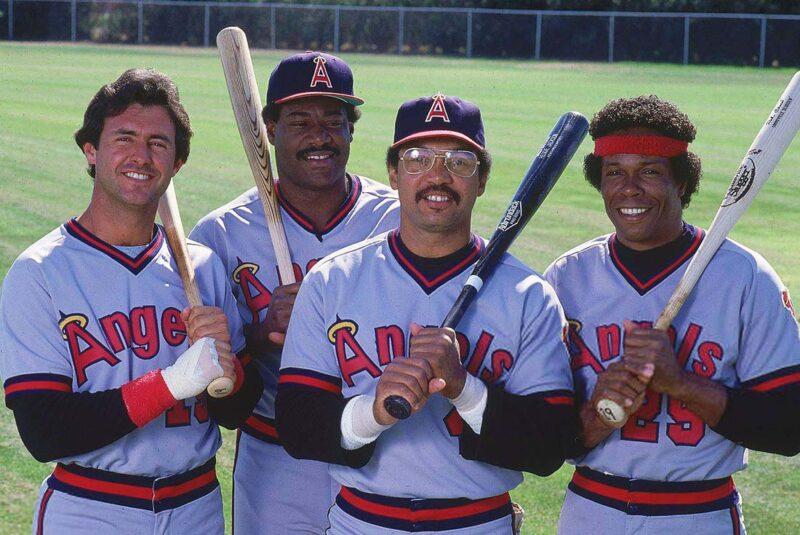
No big deal, just four MVP’s in one shot. The California Angels’ Fred Lynn, Don Baylor, Reggie Jackson, and Rod Carew.
I always think of you as a Red Sock, but the clearest memory of you that I have as a kid was hitting a grand slam in the 1983 All-Star Game. This year it’s the 40th anniversary of that hit. The floor is yours to talk about it.
There’s some history there because that was the 50th anniversary of the first All-Star Game, which was also held at Comiskey, like the ’83 game. Babe Ruth hit the first All-Star Game homer in 1933 and I hit the first grand slam to just about the same spot; just a little further. Back then, the National League was killing us. This was my ninth All-Star Game and we lost every single one. It was the third inning and Rice had already hit a homer. We were up 3-1 and they walked Robin Yount to get to me to load the bases. That gets your attention when there’s an intentional walk in an All-Star Game. I understood the strategy though. Atlee Hammaker was the pitcher and he just had a remarkable first half. His ERA was in the low 1.00s. I remember missing a couple of breaking balls and he threw a 1-2 fastball away that missed. I knew he was coming back with that curve ball and this time I had seen it and knew what it would look like. As soon as I saw it, I recognized it and hit it great. I knew it was out and that we were up 7-1 and going to finally win. Since then, the American League has dominated [28-9].
This has been such an honor to hear so many amazing stories. I thank you for being our guest on this special 150th Spitballin’! My last question is about your Hall of Fame candidacy. Before injuries took their toll, you had nine straight All-Star Games, an MVP, Rookie of the Year, four Gold Gloves and were one of the all-around best players in the game. It’s pretty fair to say injuries derailed a certain Hall of Fame career. What are your thoughts reflecting on that?
Do I think I had the talent to be a Hall of Famer? Absolutely. I think I proved that pretty quickly. I showed that I could play with anybody. The only thing keeping me out of it is my at bats. Too many injuries. I’m not a big guy, but I played with a football mentality. I wasn’t afraid to do things on the field and it cost me. I wouldn’t trade my style of play to make the Hall of Fame. I had many managers tell me that they needed my bat in the lineup and I should quit running into walls and diving around the outfield. I couldn’t do that. If I could catch it, I’m going to catch it and give it my best effort. Back then, most walls weren’t padded. I was running into concrete or wood. I took a bit of a beating. But I’m not disappointed and won’t apologize for my style. When I was on the field, you were going to get 100% of what I had that day.
This article was originally featured at Ballnine.com By Rocco Constantino May 25, 2023
